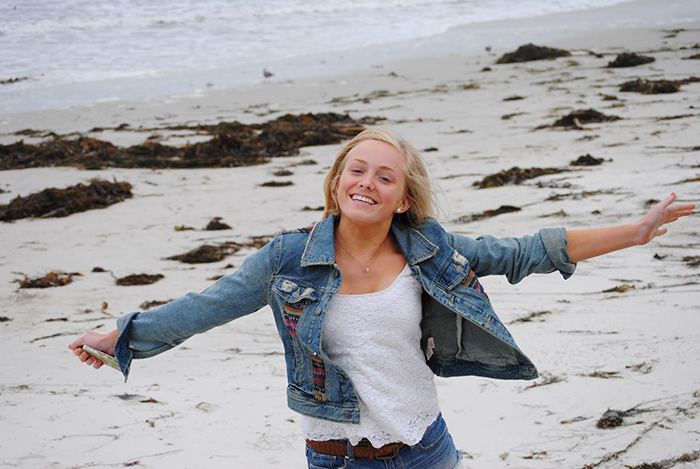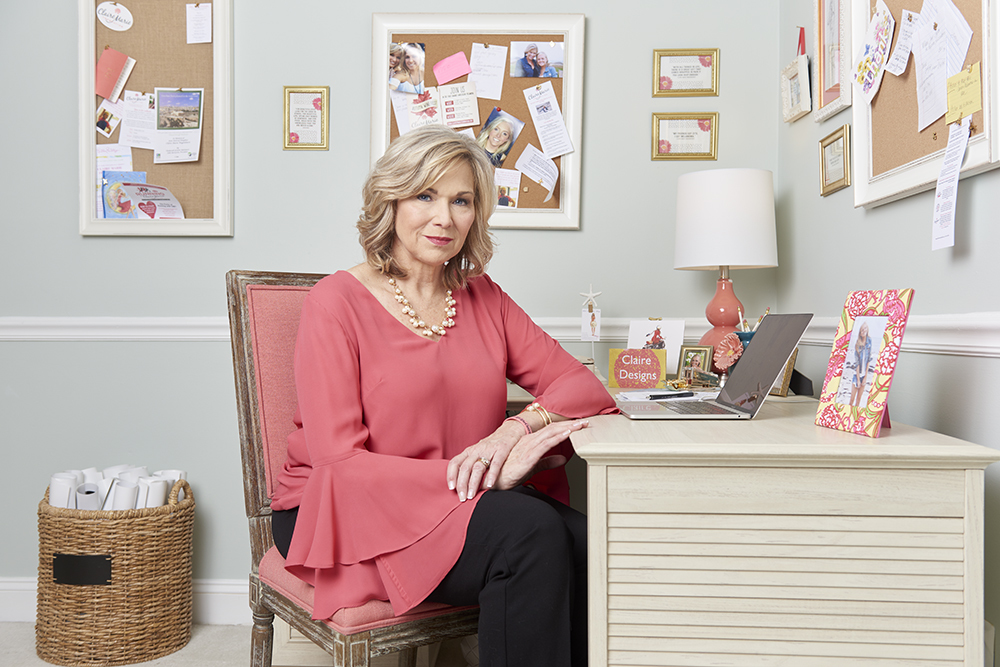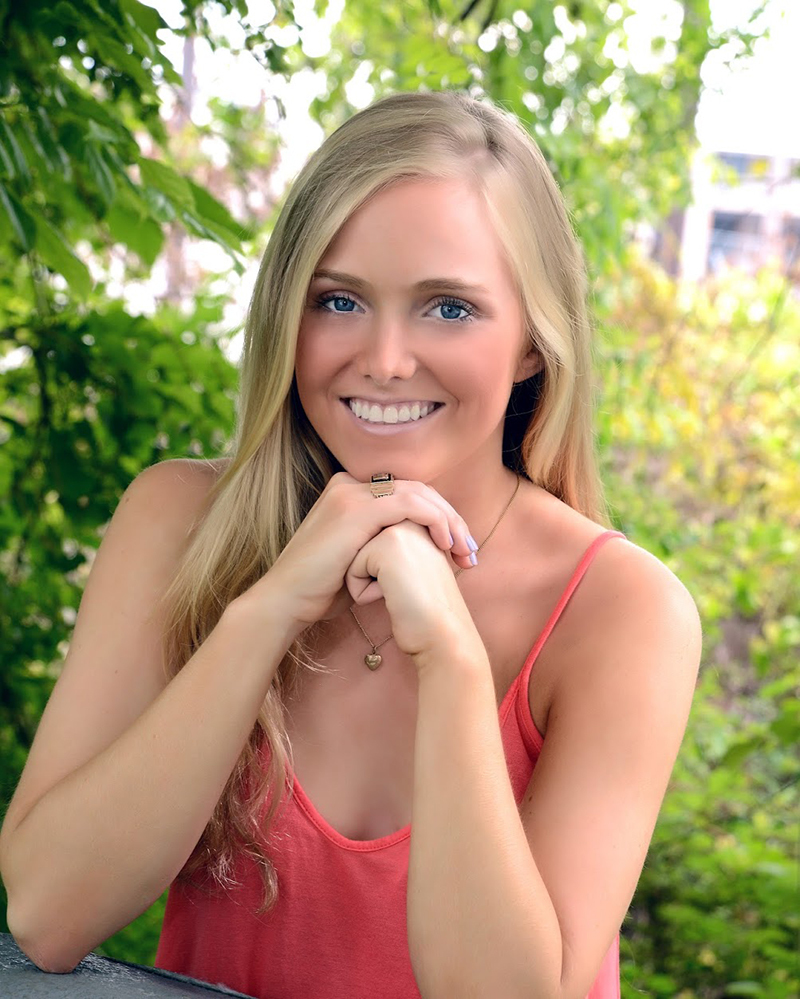Education & Family
Full Strength
Marianne Banister and Rocky Wagonhurst establish an adolescent melanoma foundation—and honor their daughter’s memory.
The quilt covering Claire Marie Wagonhurst’s bed is patterned with splashes of coral, purple, pink, and red. Her closet doors heave from the weight of an impressive handbag collection. An Audrey Hepburn Breakfast at Tiffany’s poster hangs on a nearby wall, while a stack of books, including one written by lifestyle guru-actress Lauren Conrad—Claire’s idol—sits on her night table. Claire’s vibrant personality permeates this place—the only thing missing is the young woman herself, who died, at 17, after a three-year-long battle with melanoma.
Although several years have passed since her death on October 16, 2014—the start of her senior year at Notre Dame Preparatory—Claire’s room keeps her mom, Marianne Banister, connected to her. “It’s like I get to be with her,” the former WBAL anchor explains. “I leave the door open, because I feel like she’s here. It’s as if she was coming home.” And while it’s an immutable fact that the blonde, blue-eyed teen will never come back to the home that she shared with her mother, her father, Rocky Wagonhurst, and her older sister, Hillary, the fact that Claire battled the deadly cancer at all still mystifies them.
“After we got the diagnosis, I was trying to figure out what the hell happened,” says Banister. “She never went tanning. She lived in sunscreen, and she got checked annually—she did everything right. The fact that she’s not here makes absolutely no sense—no sense. She should be here.”
Claire should be here—it’s a phrase that Banister circles back to in conversation, again and again. She should be here.
Because Claire isn’t here, Banister and Wagonhurst have made it their mission to keep other teenagers—and their families—from suffering the same fate. From her home office adjacent to Claire’s room, which features a wall filled with her daughter’s witty tweets (Y’all need Jesus; Showers solve all my problems), Banister has found a place to channel her pain. She’s made it her mission to teach young people about melanoma and raise awareness about the lethal cancer commonly known to be brought on by sun exposure, but, as happened in Claire’s case, can be triggered by hormonal changes in puberty.
Melanoma—even more aggressive and invasive when found in young people—has reached epidemic proportions, according to The Skin Cancer Foundation. Diagnoses of melanoma in children, adolescents, and young adults have increased more than 250 percent over the past four decades, with one tanning session bringing an increased risk of 75 percent. The disease is the most common cancer for young adults 25-29 years of age, and the second most common cancer in adolescents and young adults ages 8-30, according to The Skin Cancer Foundation.
In the immediate aftermath of Claire’s death, her friends, many of whom never knew she was gravely ill, organized a charity ball at Loyola Blakefield, raising $24,000 in her memory. The money raised led to the inception of the Claire Marie Foundation, which has taken on a life of its own, helping to educate others about the disease and offering free annual screenings to youths and young adults, an age group that doesn’t ordinarily get screened. To date, more than $200,000 has been raised through individual donors and events, and nearly 500 young people have had screenings.

To Banister’s knowledge, it’s the only nonprofit in the U.S. for the disease that focuses exclusively on this particular population. When the foundation was started, it didn’t have so much as a logo. “But at that point,” says Banister, “we knew that we had the attention and the interest of the other kids. They were listening to us and thinking about her, and we knew if we wanted to start with this young community of kids that it was time to move forward.”
Now The Claire Marie Foundation has not only a coral-colored logo (Claire’s favorite color), but the organization has partnered with the Department of Dermatology at Johns Hopkins Medicine to offer educational programs to pediatric and dermatological residents on how to screen for melanoma in kids and teens. Plans are also in the works to partner with Roger Daltrey’s and Pete Townshend’s Teen Cancer America, a nonprofit dedicated to improving the lives of young people with cancer. The Claire Marie Foundation has also set up a peer-to-peer network of collegiate ambassadors, many of them friends of Claire’s, across 32 campuses nationwide, to help increase awareness. And, in Claire’s honor, there’s also an annual scholarship fund at Notre Dame for promising design artists.
While Banister works on a daily basis for the foundation, Wagonhurst, director of sales at WJZ-TV, attends foundation events and helps spread the word in any way that he can. “We don’t want to see anyone else go through what we’ve been through,” says Wagonhurst, who honored his daughter by biking 630 miles from Charleston to Georgia Southern in Statesboro, and then to the University of Alabama in Tuscaloosa, where Claire had been accepted the day before her death. “We feel like we have to tell the story as much as we can. It’s hard, though, because it’s so personal. Marianne is the force behind it. I’m the dad—you fit in where you can.”
A few weeks before Christmas, during one peer-to-peer program, Banister sits among a crowd of some 50 Towson University Greek Life students. Several Towson student ambassadors are also on hand to help with the presentation, which includes a video about adolescent melanoma. Prior to the presentation, the video malfunctions, but the former newswoman remains cool and collected. “That’s fine,” she says, “we’ll make do.”
Student Tommy Oswald, an acquaintance of Claire’s, begins. “On October 16, the day after getting into the University of Alabama, Claire passed away from melanoma,” he says. “She was an athlete, an aspiring artist. It was a big deal when it happened. I went to her funeral and there were kids from all over the area. I saw the impact that she had—we need to learn how we can take care of ourselves, and we are the next generation of parents. Unfortunately, this can happen to any of us.”
One ambassador tells the group, “Before Claire, I had no idea what melanoma was.” Eventually, Banister moves from her seat to address the students. “Claire was my girl,” she says. “She should have been a junior this year studying interior design in Milan. I don’t want to scare you, but scaring you gets your attention. Melanoma is the second most common cancer found in adolescents and young adults. Melanoma metastasizes—it’s a beast. It’s a risk for every person on the planet—and it’s not always about the sun.”
After speaking for 15 minutes or so, Banister asks the students if they have any questions, but they seem unusually subdued, and no one says a word, as if to let her words sink in. “Carry this new awareness forward,” she says, breaking the silence. “Now, go have a great life.” As they file out, 22-year-old senior Abby Havermann turns to a friend. “I’m so glad I stopped tanning,” she says in a whisper.

Before melanoma, Claire Marie Wagonhurst loved lacrosse, field hockey, and cross-country running. She had a large circle of friends, a thing for Lilly Pulitzer, and a firm sense of her future. “She was deciding between interior design and fashion design,” says Banister. “One day, Rocky found that someone had been looking at real estate in Charleston [on the internet], and he said, ‘Is someone moving to Charleston?’ And Claire said, ‘Oh, that’s me.’ She decided she would open a shop on King Street and would live above it.”
Claire was born at Greater Baltimore Medical Center. At birth, she had a mole on the bony part of her right ankle. While most kids do not get annual skin checks at the dermatologist, Banister, with her background as a health reporter, made sure that both Claire and Hillary went for routine checks.
In June 2011, Claire noticed that the mole had turned cloudy and dusty. Her pediatrician agreed that it should be removed, but it took three months before Banister was able to book an appointment with a plastic surgeon. “I was told by the plastic surgeon’s office not to be a helicopter parent,” she recalls. “I was told, ‘Kids don’t get melanoma.’”
In September of the same year, Claire was finally seen by a plastic surgeon. Yet another few weeks went by before the mole was removed and sent for biopsy. “The plastic surgeon took it off, but assured me it was fine,” Banister recalls. Nearly three weeks had gone by when Banister realized that she hadn’t gotten back the biopsy results. She assumed that there was nothing to worry about. “I’m thinking, ‘It must be fine, otherwise, they would have called back,’” she recalls.
“I was a reporter for many years, so here’s your headline: Puberty Can Trigger Melanoma.”
But on October 7 of that year, Banister was just returning home at the end of the day when the call came. “It was the plastic surgeon saying that the biopsy had come back and that my Claire had melanoma,” recounts Banister. Stunned by the news, Banister sat in the car as the reality set in. “She was at cross-country practice and I’m thinking her whole world has just changed, and she has no idea,” she says. To some extent, neither did Banister. “I didn’t understand the fatal nature of melanoma,” she says. “I hadn’t researched it yet. I knew it was the most severe form of skin cancer, but I also knew that skin cancer is 90 percent treatable. I thought that if they didn’t think she could get it, and it took so long to hear back, it must be early on.”
With the diagnosis, Banister quickly went into reporter mode. What she discovered surprised her. “All the documentation is based on an adult population, an average of 50 years old, because, traditionally, that’s where the greatest number of patients are,” she says. “If you look at all the melanoma cases, they are mostly men over 50. All the studies were based on this older population—we were in No Man’s Land.”
Through her research, Banister was surprised to learn that melanoma could strike young people. “[Because of ozone depletion], the sun is more intense now than when we were kids,” she points out, “so the risk is higher. They now know it can also be triggered by hormonal factors, where it used to be assumed it was always the sun. I was a reporter for many years, so here’s your headline: Puberty Can Trigger Melanoma, but nobody talks about that.” Claire’s treatment was a roller-coaster ride entailing 10 surgeries (including a lymphadenectomy and a skin graft), a course of eight types of drug therapies (including chemotherapy, radiation, and Interferon), and an alphabet soup of diagnostic procedures from PET scans to MRIs.
During the three years she lived with melanoma, she was in remission twice, but in May 2013, nearly two years after the change in the mole was first discovered, Claire had a recurrence. This time, melanoma cells appeared in an internal abdominal node. Through it all, Claire was resolute, telling only her closest friends. “She didn’t let it define her,” says Banister. “She had a full life.” Adds Rocky, “She felt like this was going to be a bump in the road, that we would make it through it, and it made her look at life in a different way. She made sure she squeezed every joyous moment out of every day.”
Several months before her death, the disease had progressed into leptomeningeal carcinomatosis—with the cancer traveling to the membranes surrounding her brain. Even up until the end, Wagonhurst says, he truly believed that they could save her. “I’m her dad,” he says, his voice cracking with emotion. “I’m supposed to be able to fly.”
The day before her death, Claire woke up with a slight fever and a set jaw—“that was a sign,” recalls Banister. “We had to call hospice that quickly and get Hillary home from school in Arizona. Within 24 hours, we had lost her.”

Back at home, just before Christmas, Banister reflects on her new role as the founder of the Claire Marie Foundation. “It gave me something to move forward with,” she says. “We had to make some sense of it—we knew we couldn’t just sit there and hear that it had happened to someone else. I couldn’t be complicit and not share. My profession is to share information with others. That’s who I was, and my previous professional experience comes full circle.”
Banister admits that there are still plenty of days when it’s hard to get out of bed. “The loss of a child is a different kind of loss, because there is the expectation of a future, because it’s an unnatural act,” she says. “When you think of it, we have the term ‘orphans’ for people who’ve lost their parents. We have widows and widowers, but what’s the name for someone who has lost a child? We don’t have a name for it because we can’t fathom it. When parents say I’m an inspiration, I don’t want to be thought of as that—I’m just trying to get through the day.”
The grief, says Banister, has simply become a part of everyday existence. “It’s a grief that you wear daily—and not by choice,” she says. “You think of it first thing, and you think of it last, and it’s always on your shoulder throughout the day.” The Christmas holidays are particularly tough on the family. “The first year we couldn’t be home,” says Banister. “The second year we went up to Western Maryland to do something different, 2016 was our first Christmas at home, and last year was our first traditional Christmas at home. I try to reclaim what we’ve always done, but in a new way.”
That also includes moving ahead with some home projects. “We are just getting new furniture and redecorating, just starting that process, because we would have anyway. Claire was going to redecorate this room,” she says of the great room, “and we were going to be her first clients. We are just trying to reinvent ourselves.”
For now, Claire’s bedroom will remain the way it was on the day of her death, though Banister acknowledges that there will come a time when that gets redecorated, too. “Maybe when she would have graduated from college,” she muses. “Maybe that would make sense, like going through the cycle with her. In the meantime, I feel her strength.”
